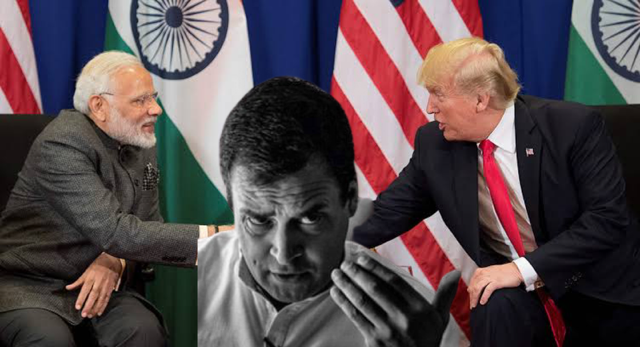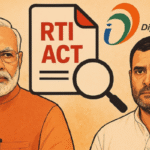When Rahul Gandhi stood up in the Lok Sabha to speak on Operation Sindoor, one expected at least some semblance of national unity following a successful and widely applauded military response to the Pahalgam terror attack. Instead, what unfolded was a brazen, meandering tirade, an attack not just on PM Modi, but on the very doctrine of Indian sovereignty, deterrence, and diplomatic stability.
Gandhi called Operation Sindoor a public relations exercise meant to protect Modi’s image, claimed the military’s hands were tied, and accused the government of lacking political will. But beneath the cluttered emotionalism and theatrical barbs lay a more sinister strategy: to provoke Modi into an uncalculated reaction and derail India’s carefully constructed, long-term foreign policy posture, especially with the United States.
Deliberate provocation: Rahul’s real target is Modi’s US strategy
One of the most revealing moments in Rahul Gandhi’s speech was when he dared PM Modi to call former U.S. President Donald Trump a “liar” on the floor of Parliament. This was not just political rhetoric; it was a trap. Gandhi was baiting Modi to react emotionally, to rupture the fragile but functional Indo-US equilibrium that the Modi government has sustained with patience and foresight. With the mercurial behaviour Trump has demonstrated ever since he came to office for the second time, one can image what a direct confrontation between India and the United States could mean for New Delhi, especially when India is eyeing to become the West’s favoured nation in terms of trade after their fallout with China.
However, Modi’s refusal to take the bait is emblematic of his broader strategy: engage the U.S. on India’s terms, not as a junior partner, but as an assertive, autonomous power. India simply cannot afford to play geopolitical roulette, especially when its domestic industries, digital infrastructure, and defense architecture are still transitioning toward greater self-reliance. Gandhi’s goading isn’t about accountability; it’s about sabotage. A deliberate ploy to undermine India’s interests so that he could later use them as props in his propaganda efforts to malign the Modi government for electoral benefits.
Modi’s approach: Restraint, leverage, and strategic patience
Contrary to the “lack of courage” slur Rahul Gandhi tried to attach, Operation Sindoor was a masterclass in precise, deliberate statecraft. Within 48 hours of the horrific Pahalgam terror attack, India launched a targeted military operation that destroyed multiple terror infrastructure hubs inside Pakistani territory. PM Modi revealed that the ceasefire was not due to international pressure but because Pakistan was on its knees, pleading for mercy.
As he told the House, no world leader asked India to stop. When U.S. Vice President JD Vance called Modi in the middle of a military briefing, Modi made it clear:
“If that’s their intention, it will cost them dearly. Goli ka jawab gola se denge.”
India didn’t need to bomb civilian cities to prove a point. It did exactly what was necessary: establish deterrence, avoid escalation, and preserve geopolitical capital. That is leadership. That is strategy.
In fact, a recent article in the New York Times titled “Flatter, Defer, Nudge: Europe’s Playbook for Trump Yields Some Results” underscores what world leaders are doing to keep themselves in good books of the US president and prising out best possible trade deals for their respective countries by employing a mix of cajolement, charm offensive, and measured disagreement. A hostile confrontation with Trump could threaten a country’s prospects, as witnessed after the fiery spat with Ukrainian President Zelensky following which the United States had temporarily halted weapons supply to the beleaguered nation embroiled in a conflict with neighbouring Russia.
Global South, Russia, and Redefining Independence
More importantly though, Modi’s broader foreign policy is not driven by the need for headlines but by the goal of reducing India’s historic dependence on Western hegemony. First, India is positioning itself as a voice of the Global South, deepening ties with Africa, Latin America, and ASEAN while reshaping BRICS into a geopolitical counterbalance to Western groupings.
Second, India’s relationship with Russia remains strong, not out of nostalgia but pragmatism. During the Ukraine crisis, while Europe and the U.S. expected India to fall in line with their sanctions regimes, India maintained a neutral, sovereign stance. This infuriated the Western deep state but proved India is no longer beholden to anyone.
Third, and perhaps most crucially, Modi has quietly but decisively begun building the foundation for tech and data sovereignty, an issue of immense geopolitical relevance that Congress either ignored or actively compromised.
Tech sovereignty: Lessons from the West’s censorship machine
The Ukraine war laid bare a reality that India can no longer ignore: Big Tech is an extension of U.S. foreign policy. From Meta and Google to YouTube and Apple, American platforms weaponised their algorithms to shape narratives, censor content, and enforce Washington’s geopolitical objectives.
If tomorrow, India were to have a disagreement with the U.S. on trade, tariffs, or Kashmir, what’s to stop these same companies from suppressing Indian voices or pushing anti-India narrative globally? This is not paranoia; it’s precedent. The Modi government has seen this and begun building its defenses.
India’s India Stack, Digital India Act, and Semicon India push are just the beginning. Localisation of data, tighter regulation of cross-border digital flows, and the emphasis on open-source public digital infrastructure are all designed to reduce the chokehold of American tech giants.
The Nayara case: India’s battle for sovereignty, one sector at a time
A key flashpoint that illustrates this battle is the Nayara case, involving India’s push to reclaim control over critical national infrastructure from foreign stakeholders. On the surface, it’s about a private energy deal, but at its heart, it’s about ensuring foreign capital doesn’t translate into political veto power. Whether it’s in energy, data, or defense, the message is clear: India must decide its future, not foreign investors or foreign governments.
Congress and the US deep state: A history of submission
Ironically, it is the Congress party that should be the last to question India’s current foreign policy posture. Under Nehru, India’s so-called non-alignment only succeeded in alienating the United States without gaining strategic depth. Indira Gandhi’s flirtation with the Soviet Union further entrenched American suspicion.
But it was under UPA-II that Congress fully surrendered to the U.S. deep state, overcompensating for decades of maintaining strategic distance. From surveillance cooperation to trade concessions, the Congress government was eager to please its Western handlers. Cables leaked by Wikileaks show just how embedded the U.S. embassy had become in India’s policy circles during that era.
Today, Modi’s government is trying to rebalance that unequal legacy. And what does Rahul Gandhi do? He parrots talking points that are indistinguishable from those pushed by hostile foreign media, Western-funded NGOs, and certain Washington-based think tanks funded by global disruptors and deep state agents like George Soros. Whether knowingly or as a useful idiot, Rahul is aiding the very forces that want to keep India dependent, reactive, and pliable.
Operation Sindoor was a message to the world, and so is this sabotage
In dismissing Operation Sindoor as a publicity stunt, Rahul Gandhi is not just attacking Modi; he is attacking the morale of our Armed Forces. He is ignoring the military’s tactical success, belittling the sacrifice of those who executed the mission, and emboldening the enemy by suggesting India blinked. As Modi very eloquently enunciated during his address to the Lok Sabha on Tuesday, India achieved what it set out to during Operation Sindoor and our Armed Forces ensured Pakistan will remember this lesson for decades to come.
However, what Rahul is insisting is chaos dressed up as “lack of political will”. This is not dissent. This is treachery dressed up as debate. And his rhetoric is not born out of bravery but out of desperation to remain relevant, even if that means pushing India into reckless confrontations or back into the clutches of global hegemons.
As Modi builds a sovereign future, Rahul sells a colonial past
Operation Sindoor was not about Modi’s image; it was about India’s message. That we will retaliate, but on our terms. That we will fight terrorism, but not to please foreign capitals. That we will assert sovereignty, not surrender it for a handshake.
While Prime Minister Modi is building a long-term architecture of independence, be it technological, diplomatic, or economic, Rahul Gandhi is busy throwing tantrums on the Parliament floor, demanding that India shout slogans rather than shape policy. In doing so, he reveals not courage, but complicity.
He may win a few viral moments, with his supporters online going gaga over their leader’s posturing in the Lok Sabha, but India cannot afford to let its future be dictated by a desperate dynast reciting scripts prepared in Washington. The age of submission is over. India is rising, not with noise, but with strategy. And no amount of posturing by a flailing “prince” can stop that momentum.












